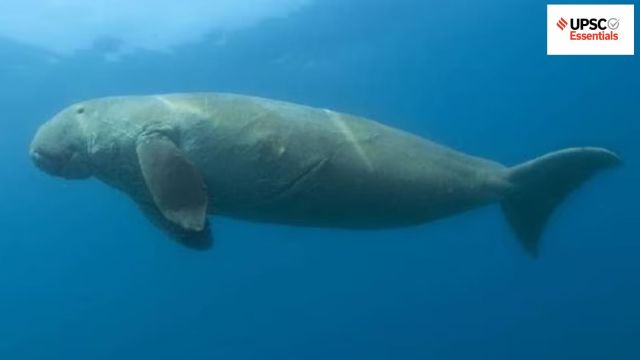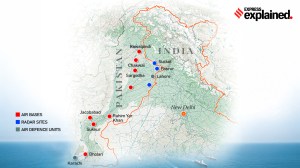UPSC Essentials | Daily subject-wise quiz : Environment and Geography MCQs on Marine Protected Areas, Miombo woodland and more (Week 109)
Are you preparing for UPSC CSE Prelims 2025? Check your progress and revise your topics through this quiz on Environment and Geography.
 Check your progress and revise your topics through this quiz on Environment and Geography. Find a question on the marine protected area in today's quiz. (Wikimedia Commons)
Check your progress and revise your topics through this quiz on Environment and Geography. Find a question on the marine protected area in today's quiz. (Wikimedia Commons)UPSC Essentials brings to you its initiative of subject-wise quizzes. These quizzes are designed to help you revise some of the most important topics from the static part of the syllabus. Attempt today’s subject quiz on Environment and Geography to check your progress.
🚨 Click Here to read the UPSC Essentials magazine for April 2025. Share your views and suggestions in the comment box or at manas.srivastava@indianexpress.com🚨
QUESTION 1
Consider the following statements about Nature Restoration Law:
1. It is the first continent-wide, comprehensive law of its kind released by Europe.
2. It sets non-binding targets to restore degraded ecosystems.
3. It is part of the EU’s European Green Deal.
Which of the statements given above is/are correct?
(a) 1 and 2 only
(b) 2 only
(c) 1 and 3 only
(d) 2 and 3 only
Explanation
— European Union countries gave final approval to a major and long-awaited plan to better protect nature in the 27-nation bloc. Hence, statement 1 is correct.
— The Nature Restoration Plan, which aims to restore ecosystems, species, and habitats in the EU, was finally adopted at a meeting of environment ministers in Luxembourg after receiving support from a qualified majority of 15 of the 27 member states and 65% of the EU population.
— The Nature Restoration Law is the first law of its sort to apply to the entire continent. It is an important component of the EU Biodiversity Strategy, which establishes binding targets for restoring damaged ecosystems, particularly those with the greatest potential to collect and store carbon, as well as preventing and mitigating the effects of natural disasters. Hence, statement 2 is not correct.
— The Nature Restoration Plan is part of the EU’s European Green Deal, which aims to establish the world’s most ambitious climate and biodiversity targets while also positioning the bloc as the global point of reference on all climate concerns. Hence, statement 3 is correct.
— The plan requires member states to reach restoration targets for various habitats and species, with the goal of covering at least 20 per cent of the region’s land and sea regions by 2030.
Therefore, option (c) is the correct answer.
(Other Source: environment.ec.europa.eu)
QUESTION 2
Consider the following pairs with reference to Marine Protected Areas and their region:
1. Dugong Conservation Reserve – Tamil Nadu
2. Point Calimere Wildlife Sanctuary – Kerala
3. Gahirmatha – Andhra Pradesh
4. Haliday Island – Maharashtra
How many of the pairs given above are correct?
(a) Only one pair
(b) Only two pairs
(c) Only three pairs
(d) All four pairs
Explanation
— A marine protected area (MPA) is essentially a zone in the ocean where human activities are more rigorously regulated than the surrounding waterways, akin to land-based parks.
— Local, state, territorial, native, regional, or national authorities have designated these areas as special protection zones for natural or historic marine resources.
| Marine Protected Area | Region |
| Dugong Conservation Reserve | Tamil Nadu |
| Point Calimere Wildlife Sanctuary | Tamil Nadu |
| Gahirmatha | Odisha |
| Haliday Island | West Bengal |
Therefore, option (a) is the correct answer.
(Source: wii.gov.in)
QUESTION 3
Salal and Baglihar Dams were in the news. These dams are both constructed on:
(a) Jhelum
(b) Chenab
(c) Sutlej
(d) Beas
Explanation
— The Chenab River nearly dried up in Jammu and Kashmir’s Akhnoor sector near the Line of Control when the sluice gates of two big dams, Salal and Baglihar, were closed.
— According to the IWT, the Chenab is one of three “Western Rivers” that Pakistan controls, along with the Indus and Jhelum.
— However, India has restricted access to the waters of the three Western Rivers for residential, non-consumptive, agricultural, and hydroelectric power generation purposes.
— India is permitted to construct run-of-river facilities on the three Western Rivers in order to create hydroelectric power. A run-of-the-river plant generates electricity from the natural flow of water. Salal and Baglihar on the Chenab are run-of-the-river projects.
Therefore, option (b) is the correct answer.
QUESTION 4
With reference to the slender loris, consider the following statements:
1. They are nocturnal mammals.
2. They act as a biological predator to pests of agricultural crops.
3. It is listed as critically endangered by the International Union for the Conservation of Nature (IUCN).
How many of the statements given above are correct?
(a) Only one
(b) Only two
(c) All three
(d) None
Explanation
— Slender lorises are small nocturnal mammals and are arboreal in nature, as they spend most of their life on trees. Hence, statement 1 is correct.
— They are commonly found in the tropical scrub and deciduous forests as well as the dense hedgerow plantations bordering farmlands of Southern India.
— These species are listed as endangered by the International Union for the Conservation of Nature (IUCN). Hence, statement 3 is not correct.
— They act as a biological predator to pests of agricultural crops and benefit farmers. Hence, statement 2 is correct.
— The sanctuary would play an important role in conservation of slender loris and yet another milestone in conservation efforts.
Therefore, option (b) is the correct answer.
QUESTION 5
Miombo woodland is a
1. Dryland forest ecosystem
2. It comprises tropical and subtropical grasslands, bushlands, and savannahs.
3. found in Northern Africa
Select the correct answer using the codes given below:
(a) 1 only
(b) 2 and 3 only
(c) 2 only
(d) 1 and 2 only
Explanation
— The United Nations Food and Agriculture Organisation (FAO) and the Italian Agency for Development Cooperation (AICS) have signed two agreements to conduct initiatives aimed at safeguarding the miombo forest and enabling trade along Mozambique’s border with Zimbabwe.
— The Miombo biome comprises tropical and subtropical grasslands, bushlands, and savannahs.
— Miombo woodland is a huge African dryland forest ecosystem spanning almost 2.7 million square kilometres in southern Africa, encompassing Angola, the Democratic Republic of the Congo, Malawi, Mozambique, Tanzania, Zambia, and Zimbabwe.
Therefore, option (d) is the correct answer.
(downtoearth.org.in)
Previous Daily Subject-Wise-Quiz
Daily Subject-wise quiz — History, Culture, and Social Issues (Week 108)
Daily subject-wise quiz — Polity and Governance (Week 109)
Daily subject-wise quiz — Science and Technology (Week 109)
Daily subject-wise quiz — Economy (Week 109)
Daily subject-wise quiz — Environment and Geography (Week 108)
Daily subject-wise quiz – International Relations (Week 108)
Subscribe to our UPSC newsletter and stay updated with the news cues from the past week.
Stay updated with the latest UPSC articles by joining our Telegram channel – IndianExpress UPSC Hub, and follow us on Instagram and X.
Must Read
Buzzing Now
May 14: Latest News
- 01
- 02
- 03
- 04
- 05


























